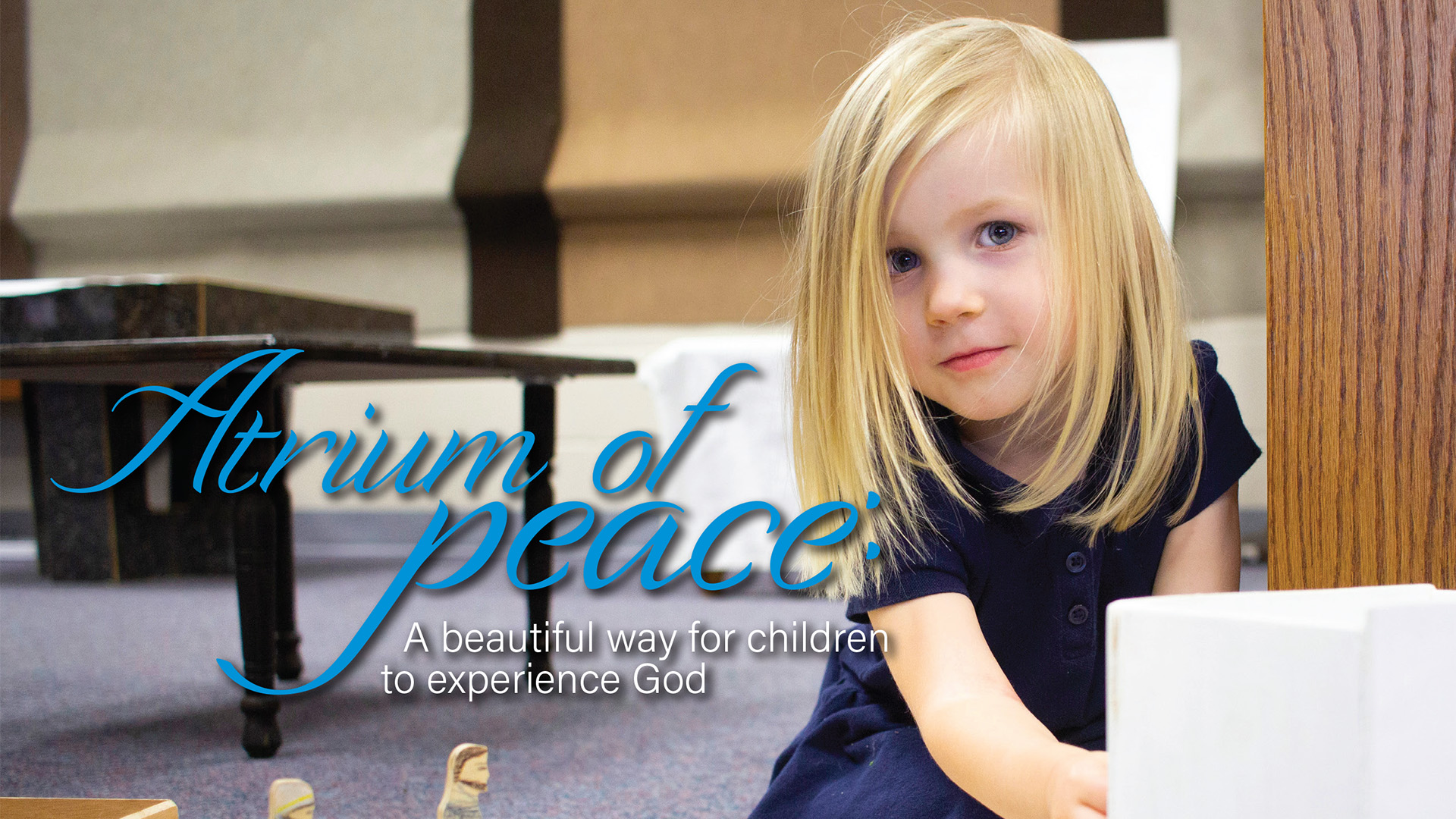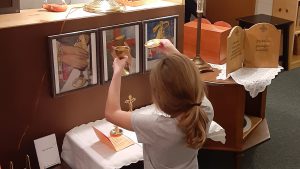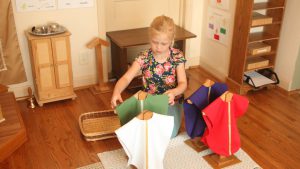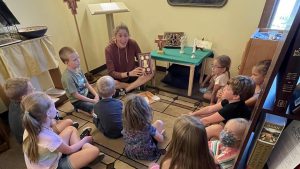
By Pauline Lev
Imagine walking into a quiet, naturally lit room dotted with low shelves containing various items. Everything in the room has a place, and everything is in its place. The room has a simple beauty that alludes to peaceful order. There are 10 children in the room, all between the ages of 3 and 6.
In one corner, a child works at a small model altar, placing a model chalice, paten and crucifix on it, naming them, and prayerfully enjoying the beauty of the simple setting. At a low table a child is slowly and carefully pouring dry beans from one glass container to another. She does it again and again.
At a small rug on the floor, an adult is proclaiming the Scripture of the Annunciation to a 4-year-old. There is a lit candle, and after reading the Scripture, the adult leads the child to ponder this mother who has been given the light of the world to carry within her and share with the world. The other children are spread throughout the room, working with other various materials, and one other adult sits in a corner observing the children’s work and taking notes.
A full silence emanates throughout the room. Sometimes a quiet song is sung. Sometimes a child expresses gratitude after working and pondering something together with an adult. Often there is joy, shown through the children’s smiles and exclamations of happiness that seem to erupt from their innermost self. Sometimes there is skipping and jumping with exhilaration, but a stillness and calm prevails even in their joyous proclamations.
It is a place where children can hear God in the silence. It is not a forced silence, but a chosen silence, and the silence grows as the children enter more deeply into their work, which lasts for one and a half to two hours.
If this sounds impossible, unrealistic and ridiculous to you, I’m not surprised. But it is possible, and you can find special environments such as the one described above in many places in the United States and the world, and even in our own diocese. These special environments are called atriums, and they are a part of a catechetical method called Catechesis of the Good Shepherd (CGS).
Meeting the needs of the child

CGS was started in Italy in the 1950s by biblical scholar Sofia Cavaletti and Gianna Gobi. These women developed this method of catechesis based on what Maria Montessori had discovered about the developmental and spiritual needs of children between birth and age 12.
There are currently four nationally sanctioned levels of CGS formation available in the United States: level one, for children ages 3 to 6; level two, for children ages 6 to 9; level three, for children ages 9 to 12; and there is a toddler level for those under the age of 3. As the needs of the children change depending on their age and development, so, too, does the content of the atrium shift and deepen to meet their growing needs at each stage.
Rachel Uhrich, director of CGS at Risen Savior Parish in Brandon, says “[CGS] honors the dignity and developmental stage of children and uses what we know about the characteristics at different developmental stages to best provide them with materials and content suitable for their personal encounter with Jesus Christ.”
You can see this evidenced in many ways in an atrium. Everything is child-sized and made for them to use. There are cleaning supplies, such as a broom and duster, and trays for polishing metal and wood items within the atrium in order to allow them to partake in taking care of the beautiful environment they are a part of.
One area of the level one atrium is dedicated to practical life exercises. Trays are set up for things like pouring beans, pouring water, pouring water into a funnel, folding cloth napkins, and other such basic tasks. These basic repetitive movements and tasks honor their developmental stage. Young children have a deep desire to master their physical movements, and this desire leads them to careful concentration.
This concentration lays the foundation for contemplation, both in the immediate work at hand as it slows them down, but also in the time ahead when they will be introduced to liturgical and Scripture presentations in the other areas of the atrium. Within a few weeks, children who have engaged with the practical life works are much better able to participate in scripture proclamations and liturgical presentations because of their internalized practice of repetition and concentration.
After a child has been shown a work, they are free to go back to that work whenever they would like. It is not a free-for-all; there are well established grace and courtesy lessons that are practiced and routinely reviewed and the children desire to follow these necessary guidelines so they can all work peacefully in community.
“I cannot help but believe that they are deeply guided by the Holy Spirit … the work that they choose often results in noticeable fruits such as joy, peace, patience, kindness, generosity and self-control,” says Rachel. “The presence of these fruits in the atrium indicate the very real presence of the Holy Spirit working in the hearts of the children.”
The level two and three atriums include much more writing and drawing than level one. A child over the age of 6 now has what Maria Montessori called a reasoning mind—they are consciously learning and thinking. These children are aided through writing or copying what they have heard and drawing what those words mean to them. This helps them to continue to contemplate and draw out deeper meanings, as well as synthesize different concepts they have heard to reach a new depth of spiritual meaning. In this way the work of the atrium is designed to fit the needs of the child. Their work becomes prayer because they are able to engage with it in a way that fits their development.
Catechetical pillars of CGS
Catechists who work with children in the atrium are called guides. Their role is not one of simply passing on information, but rather to remember the Holy Spirit is the ultimate catechist. The child is in need of a guide to proclaim God’s word to them and to wonder alongside them at the greatest truths of our faith. Each level of CGS takes 90-120 hours of formation in order to be a guide to children at that level.
Carolyn Kohlhass, director of CGS at Way of the Shepherd School in Coon Rapids, Minnesota, has been a formation leader since 2009 and involved in CGS since 2006. “When you step into the atrium with the children, you’re not so much reading from a script,” says Carolyn, “but you’re authoring truth to them in a way that can fit their needs. We have a banquet of truth we’ve been given,” and the guide asks: “what will fit this child in this moment?”
The guide has an arsenal of different presentations they can give to children. All of these presentations come either from Scripture or liturgy. Every CGS presentation flows from one of these two pillars. Presentations follow the liturgical seasons, introducing the children to the liturgical year and helping them to partake in the life of the Church.
From the pillar of Scripture, the children are introduced to the incarnation of Jesus through geography presentations on the land of Israel and the infancy narratives from the Gospel of Luke. They also hear some of the prophecies from the Old Testament and several of the kingdom of God parables from the New Testament.
The guide proclaims the stories straight from the Bible, and each presentation includes some sort of sensorial or visual work to aid the child’s contemplation. The children listen carefully and ponder with the guide the truths about God that are revealed through his word. After meditating, children are invited to respond in some way to what they have heard. Sometimes children sit and pray in silence, sometimes they respond with a prayer of gratitude and joy, and sometimes they will write or draw a response.
In the later levels, more Scripture is presented, such as the moral parables in level two as they prepare for sacraments, and typology studies with the Old Testament in level three.

From the pillar of liturgy, children experience presentations surrounding baptism and the Eucharist. They are shown many of the articles and gestures of these two great sacraments, not just to see them, but to ponder the depths of the meanings behind them and the gift they are to us. These great sacraments are how Jesus remains with us and how we can receive his risen light, and in CGS the children respond with much joy and gratitude to these greatest of mysteries.
All of these things lead to the presentations on the paschal mystery, given during the Lenten and Easter seasons. The Easter Vigil is the pinnacle moment of the liturgical year and this is evident in CGS. You could say that every presentation is preparing the child to penetrate in a small way the deep mystery of Jesus’ death and resurrection.
Amid all of these presentations, the hearts of the children are moved not because of the information shared, but because of the relationship that is ever deepening between them and Jesus as they ponder all he has given to them through Scripture and the Church. The children have an “ability to receive his love without any sort of deflection or demurement,” says Carolyn. “There’s this ability to really open and enjoy his goodness.”
In this way, the method is not trying to pass on information and definitions, but a real, lived relationship with the God who created them and loves them.
“CGS understands well that rather than focusing solely on intellectual or moral instruction, the preeminence of personally knowing and receiving the love of God must come before all else,” says Rachel. “Only resting on that foundation can moral or religious obligations be received with joy and love.”
A gift for all
While CGS was developed to meet the religious needs of the child, it’s no surprise adults have been transformed by this work as well.
“It is very humbling and even convicting to walk with the little ones,” Rachel says. “My own faith, hope and charity has been strengthened by witnessing the Good Shepherd work in the hearts of the children that I serve, and their response to him of profound love and joy.”
“Being with the children in the atrium has been probably one of the greatest gifts of my life,” says Carolyn. “The atrium really seems to be this place where children of all ages, including adults in formation, can really encounter God’s love.”

Carolyn has had many adults come back to formation again and again, even repeating the same levels, because of how much formation has changed their lives and deepened their relationship with Jesus and the Church.
“They hear it in what we give to 3-year-olds,” says Carolyn. “It’s disarming, like it breaks down our own defenses as adults to hear the beauty of the truth as well.”
“Formation courses are retreat-like in nature [and] have a meditative quality that allows for prayer and deep internal transformation,” says Rachel. “Regardless of how you use the formation, I guarantee that it always has the possibility to be life-changing.”
Families of children in CGS have also been inspired by what their children have experienced in the atrium. Rachel has had so many parents ask her about what she does in the atrium with the children that last summer she put on “adult atrium sessions” for those interested to come and see what the atrium is like and to receive some of the presentations.
“In this work, I have seen so many parents draw nearer to our blessed Lord and the Church through the fruits of their child’s time in the atrium,” she says.
Father Andy Young, pastor at Risen Savior Parish in Brandon, says CGS has been a great gift to the parish.
“CGS is very hands-on teaching for the children and introduces them to themes and concepts that oftentimes our adults struggle with understanding,” Father Young said. “When children come home and talk about the concepts they are learning, parents are often amazed. More and more families [at Risen Savior] are seeing the impacts CGS is having on their children and opting for that approach.”
Children who have spent many years in the atrium are aware of the presence of God in their life and desire to follow him. In this way, CGS also leads to discipleship. These children have fallen in love with Jesus the Good Shepherd and his Church and want to lead others to his sheepfold as well. Rachel and Carolyn both think it is a fitting method of catechesis for the apostolic times we live in.
“One reason that CGS is particularly appropriate for the apostolic times in which we live is because CGS fosters a sacramental and transformed vision of the world,” says Rachel. “Children and catechists in the atrium learn to look at the world in a way that is much different than the secular culture’s view of the world and of life.”
To really have an idea of what the atrium is and the religious life that is lived within, one must “come and see.” It is not something you can easily understand and certainly not experience without having seen and experienced it for yourself. Both Rachel and Carolyn attest that parents or interested adults would be best served to see the beauty of the method by observing an atrium session and seeing the Holy Spirit at work firsthand with the children.
“I have had many people who left the atrium in amazement and awe, never having experienced anything like it,” Rachel said.
At the end of the day, CGS is kerygmatic, meaning it speaks to the heart of the Gospel message of God and his love for each of us, and Christocentric, meaning it is focused on the means by which God shows us his love: his Son, Jesus.
“CGS aims to help foster communion and intimacy between the child and God,” says Rachel. “At the heart of CGS, as at the heart of the Gospel, we find a person, Jesus Christ, who suffered and died for us and rose again to share his risen life with us.”
These deepest truths of our faith are what children and adults in the atrium ponder deeply together, and no wonder it is a place of profound peace, gratitude and joy.
Want to learn more about CGS? Check out this video for a tour of the CGS Atrium at Risen Savior in Brandon.


